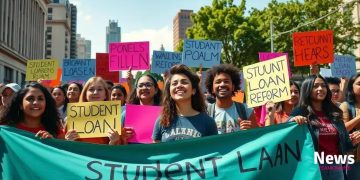Navigating student loans: effective strategies for repayment

Navigating student loans requires understanding various repayment options, utilizing forgiveness programs, and applying effective debt management strategies to achieve financial freedom.
Navigating student loans: This journey can be daunting for many recent graduates. With the right strategies for repayment and knowledge of forgiveness programs, you can minimize stress and focus on building your future. Let’s explore how to make the most of what you have.
Understanding the basics of student loans
Understanding student loans is crucial for anyone heading to college. These loans are designed to help students finance their education. However, knowing the details can help you make wise decisions that affect your future.
Types of Student Loans
There are two main types of student loans: federal and private.
- Federal loans are funded by the government, offering lower interest rates and flexible repayment options.
- Private loans come from banks or credit unions and usually require a credit check.
- Direct Subsidized Loans do not accumulate interest while you are in school, making them a great option for many.
- Direct Unsubsidized Loans start accruing interest right away, so you’ll need to consider this in your budgeting.
It’s important to understand the differences to choose wisely. Each type of loan may have unique features and benefits. Students should consider their financial situation carefully.
Loan Amounts
The amount you can borrow with federal student loans is capped based on your year in school and your dependency status. For instance, first-year students typically can borrow less than those in their final years. Knowing these limits can help you plan your education costs better.
In addition, financial aid packages can also include grants and scholarships, which do not have to be repaid. Students should explore every option to help reduce their overall debt.
Interest Rates and Fees
Interest rates can vary significantly between federal and private loans. Federal loans offer fixed rates that are typically lower than private loans.
- Fixed Rate: The interest rate remains the same throughout the life of the loan.
- Variable Rate: The interest rate may change over time, potentially increasing your payment amount.
Students should compare these rates and any associated fees before choosing a lender. Being informed can save you money in the long run.
Understanding the basics of student loans empowers you to make informed financial choices. With the right information, you can confidently navigate the loan process and focus on achieving your academic goals.
Exploring repayment options
Exploring repayment options for your student loans is essential to managing your finances. There are various methods to repay, and understanding them can help you choose the best one for your situation.
Standard Repayment Plan
The most common repayment option is the standard repayment plan. This plan spreads your payments over a period of ten years, typically offering lower interest rates.
- Fixed monthly payments make budgeting easier.
- You pay less interest over the life of the loan compared to other plans.
- This option suits borrowers who can afford higher monthly payments.
Choosing a standard plan can help you get out of debt quickly.
Income-Driven Repayment Plans
If your income is low, consider income-driven repayment (IDR) plans. These plans adjust your monthly payments based on your income and family size, making repayment manageable.
- Several options exist, including Income-Based Repayment and Pay As You Earn.
- You may qualify for forgiveness after 20 or 25 years of payments.
- These plans can be a lifeline for many borrowers facing financial difficulties.
Filing your taxes accurately can ensure your IDR plan is based on the correct income.
Graduated Repayment Plan
The graduated repayment plan starts with lower payments that increase over time. If you anticipate your income will grow, this option can work well for you.
- Payments are usually lower in the early years, allowing for flexibility.
- After five years, your payments will increase, reflecting your expected income growth.
This method can be beneficial for recent graduates entering the workforce.
Extended Repayment Plan
The extended repayment plan allows borrowers to repay their loans over 25 years. This option may lower your monthly payments, but be aware that you will pay more interest overall.
Consider this plan if you’re struggling with monthly payments. It’s crucial to weigh the benefits and drawbacks of each repayment option carefully. Always look for what fits your lifestyle and financial goals.
Diving into forgiveness programs

Diving into forgiveness programs is an important step for many borrowers looking to reduce their student loan burden. These programs can provide relief under specific conditions, making it easier to manage debt.
Public Service Loan Forgiveness (PSLF)
The Public Service Loan Forgiveness program is designed for borrowers working in government or non-profit sectors. After making 120 qualifying payments, you may have the remaining balance forgiven.
- This program is available only for certain federal loans.
- You must be employed full-time in a qualifying job.
- Keep track of your payments to ensure they qualify.
Many find PSLF a great option if they want to serve their communities while alleviating some financial pressure.
Teacher Loan Forgiveness
If you’re a teacher, you may be eligible for the Teacher Loan Forgiveness program. This program can cancel a portion of your loans after teaching for five consecutive years in a low-income school.
- Forgiveness amounts can reach up to $17,500 based on your specialty.
- Eligibility varies, so check your qualifications.
- Document your years of service to secure forgiveness.
Teachers play a crucial role in shaping futures, and this program supports them in their efforts.
Income-Driven Repayment Forgiveness
Another forgiveness option is through income-driven repayment plans. After making payments for 20 or 25 years, depending on your plan, any remaining balance may be forgiven.
Income-driven repayment helps borrowers manage payments based on their earnings, making it easier to stay on track. Keep in mind that forgiven amounts may be taxable as income.
Eligibility Criteria
Exploring these options can lead to financial freedom. Understanding which programs apply to you is a crucial part of navigating student loans.
Tips for managing student debt
Managing student debt can often feel overwhelming, but there are effective tips that can make it easier. Taking control of your finances is crucial for your future.
Create a Budget
Establishing a budget is the first step in managing your finances. By creating a clear picture of your income and expenses, you can plan your payments more effectively.
- Track your spending to see where your money goes.
- Set aside funds for your student loan payments as priority expenses.
- Adjust your budget regularly to accommodate changes in your financial situation.
A well-structured budget helps you avoid missing payments and accumulating more debt.
Explore Repayment Options
Being aware of repayment options is vital. There are several plans available that can fit your financial circumstances.
- Standard repayment plans often offer lower interest rates.
- Income-driven repayment plans can adjust payments based on your income.
- Look into forgiveness programs if you qualify, which can save you money in the long run.
Review your options frequently to ensure you’re on the best plan for your situation.
Make Extra Payments When Possible
If your budget allows, consider making extra payments towards your loans. This can significantly reduce the amount of interest you pay over time.
Putting any extra money, such as tax refunds or bonuses, toward your loans can accelerate repayment. Just ensure to specify that the extra payment should go towards the principal balance.
Communicate with Your Lender
Don’t hesitate to reach out to your lender if you’re facing challenges. They can offer guidance and may have options to help.
Staying in touch with lenders ensures you are aware of any changes to your loan terms. They might provide options such as deferment or forbearance if you experience financial hardship.
With careful planning and smart strategies, managing student debt can feel less daunting. Adopting these tips can put you on the path to financial freedom.
Real-life success stories of loan repayment
Real-life success stories of loan repayment can inspire those facing student debt. Many borrowers have navigated their repayment journeys successfully.
From Struggle to Success
Many students graduate feeling overwhelmed by their loans. Take the story of Jessica, a recent graduate who started with $30,000 in student debt. By creating a strict budget, she allocated extra money toward her loans each month.
She also explored various repayment plans, ultimately choosing an income-driven repayment plan that suited her entry-level salary. With consistent payments and the payoff of her federal loans after ten years, Jessica now lives a debt-free life.
Making Smart Choices
Another success story is Adam, who prioritized his student loans right after graduation. He took on a part-time job while working full-time to make additional payments on his loans. Understanding the importance of loan forgiveness options, he secured a job with a non-profit organization and became eligible for the Public Service Loan Forgiveness program.
After ten years of dedicated service, Adam successfully had his remaining loan balance forgiven. His hard work and strategic planning paid off.
Utilizing Resources
Consider Sarah, who utilized various resources to tackle her debt. She joined online support groups where she learned about different options available for repayment. Sarah enrolled in a financial literacy course and gained insights about budgeting and loan management.
By taking charge of her situation and applying what she learned, she managed to reduce her debt by over $15,000 within five years. Her success came from both education and action.
Community Support
These stories showcase the impact of community support. Many borrowers engage with others in similar situations, sharing tips and encouragement. This moral support makes the journey less isolating.
Listening to real-life successes can motivate others to follow suit. By learning from others’ experiences, individuals can make informed decisions about managing their loans.
FAQ – Frequently Asked Questions about Student Loan Management
What is the Public Service Loan Forgiveness program?
This program forgives the remaining balance of your federal student loans after you make 120 qualifying payments while working for a qualifying employer in public service.
How can I choose the best repayment plan for my loans?
You can compare different repayment plans based on your income, loan type, and future goals. Consider options like standard, graduated, and income-driven repayment plans.
What should I do if I can’t make my loan payments?
Reach out to your lender as soon as possible. They may offer options like deferment, forbearance, or alternative repayment plans to help you manage your payments.
Can making extra payments help reduce my student debt?
Yes, making extra payments can significantly reduce the principal balance of your loans, which lowers the amount of interest you will pay over time.





